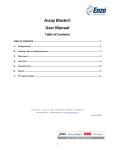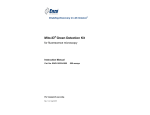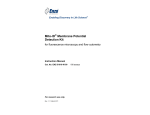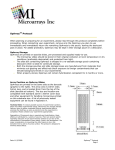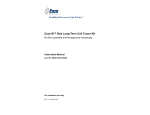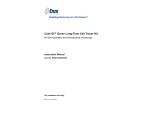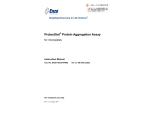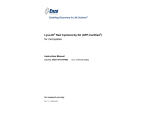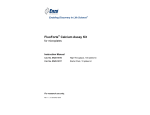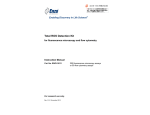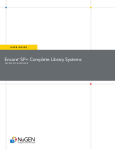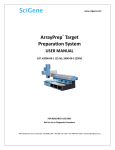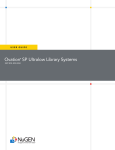Download User Manual-ENZ-42421-100 - Rev 1.1.0 April 2010.pub
Transcript
Enabling Discovery in Life Science® www.enzolifesciences.com Enabling Discovery in Life Science® 100-Reaction Single-Round RNA Amplification and Biotin Labeling System Instruction Manual Cat. No. ENZ-42421-100 NORTH/SOUTH AMERICA GERMANY UK & IRELAND ENZO LIFE SCIENCES INTERNATIONAL, INC. 5120 Butler Pike Plymouth Meeting, PA 19462-1202 USA T 1-800-942-0430/(610) 941-0430 F (610) 941-9252 E [email protected] ENZO LIFE SCIENCES GMBH Marie-Curie-Strasse 8 DE-79539 Lörrach Germany T +49/0 7621 5500 526 Toll Free 0800 664 9518 F +49/0 7621 5500 527 E [email protected] www.enzolifesciences.com ENZO LIFE SCIENCES (UK) LTD. Palatine House Matford Court Exeter EX2 8NL UK T 0845 601 1488 (UK customers) T +44/0 1392 825900 (from overseas) F +44/0 1392 825910 E [email protected] www.enzolifesciences.com www.enzolifesciences.com SWITZERLAND & REST OF EUROPE BENELUX FRANCE ENZO LIFE SCIENCES AG Industriestrasse 17, Postfach CH-4415 Lausen Switzerland T +41/0 61 926 89 89 F +41/0 61 926 89 79 E [email protected] www.enzolifesciences.com ENZO LIFE SCIENCES BVBA Melkerijweg 3 BE-2240 Zandhoven Belgium T +32/0 3 466 04 20 F +32/0 3 466 04 29 E [email protected] www.enzolifesciences.com ENZO LIFE SCIENCES c/o Covalab s.a.s. 13, Avenue Albert Einstein FR -69100 Villeurbanne France T +33 472 440 655 F +33 437 484 239 E [email protected] www.enzolifesciences.com For research use only. Rev. 1.1.0 April 2010 Problem Potential Cause Suggestion Incorrect incubation temperatures Check the accuracy of the temperatures of your incubators and thermal cycler. Reaction tube condensation Briefly centrifuge the reaction tube(s). Mix gently and move the reaction tube (s) to an incubator where condensation does not occur. RNA sample vacuum centrifuged to dryness Monitor sample volume during vacuum centrifugation to avoid drying to completion. RNA is difficult to resuspend if dried completely. Low yields with both experimental samples and control RNA Inadequate elution of (continuation..) cDNA Heat elution buffer to 70°C. Proper maintenance of temperature at this step is critical for maximal elution of cDNA from the column filter. Inadequate elution of aRNA Elute nucleic acids from column filter purification systems with enough elution solution to completely saturate the filter. Dispense the elution buffer in the center of the column bed. Incorrect spectrophotometer readings Check the accuracy of your spectrophotometer. Alternatively, use another method for quantitation of aRNA such as staining with a sensitive RNA dye. Notice to Purchaser This product is manufactured and sold by ENZO LIFE SCIENCES, INC. for research use only by the end-user in the research market and is not intended for diagnostic or therapeutic use. Purchase does not include any right or license to use, develop or otherwise exploit this product commercially. Any commercial use, development or exploitation of this product or development using this product without the express prior written authorization of ENZO LIFE SCIENCES, INC. is strictly prohibited. Limited Warranty This product is offered under a limited warranty. The product is guaranteed to meet appropriate specifications described in the package insert at the time of shipment. Enzo Life Sciences’ sole obligation is to replace the product to the extent of the purchase price. All claims must be made to Enzo Life Sciences, Inc. within five (5) days of receipt of order. Average size of control aRNA is greater than 1 kb but average size of experimental aRNA is less than 0.5 kb. Prepare fresh samples following the guidelines in Appendix A to prevent RNase contamination. Use nucleasefree plasticware and decontaminate pipettes and work surfaces with commercially available RNase decontamination solutions. RNA is partially degraded. Trademarks and Patents Enzo, is a trademark of Enzo Life Sciences, Inc. Several of Enzo’s products and product applications are covered by US and foreign patents and patents pending. 12 VIII. Troubleshooting Guide Contents Control RNA Reaction High quality Control RNA (100 ng/L, Cat. No. ENZ-42421-CR) can be used to help evaluate kit performance for troubleshooting and as an aid to first-time users. Parallel reactions with sample and control RNA (5 L, 500 ng) can be performed. Typical yield of purified aRNA generated from a 16 hr in vitro transcription reaction with 500 ng of input control RNA in the first strand cDNA synthesis reaction should be ≥ 30 g. In addition, 100 ng of the aRNA generated from control RNA can be analyzed on a bioanalyzer and results compared to the profile in Figure 1 (Appendix C). Problem Low aRNA yields with experimental samples Potential Cause Suggestion Organic, protein or salt contaminants in the input RNA Perform parallel reaction with control RNA (ENZ-42406-CR, sold separately). Use 5 uL (500 ng) in the first strand synthesis reaction. Typical yield from this input is 30 ug or more. If control RNA amplifies to this level but not your experimental samples, repurify your starting material. Use extra caution not to carry over organic organic solvents or denaturants during purification. Increase the total RNA input if the experimental RNA sample is expected to have low mRNA content. Input RNA does not contain poly(A) tracts RNA amplification with this kit requires the use of oligo dT primers. Do not substitute random or gene-specific primers with this kit. Degraded input RNA Prepare fresh sample following the guidelines in Appendix A to prevent RNase contamination. Use nuclease-free plasticware and decontaminate pipettes and work surfaces with commercially available RNase decontamination solutions. Inadequate thawing and mixing of reagents Ensure reagents are completely thawed with no solids remaining. Gently mix and centrifuge reagents briefly. Nuclease contamination Prepare fresh samples following the guidelines in Appendix A to prevent RNase contamination. Use nucleasefree plasticware and decontaminate pipettes and work surfaces with commercially available RNase decontamination solutions. Continued……. 11 II. Procedural Overview ................................................ 1 III. Reagents Provided and Storage.............................. 2 IV. Additional Materials Required ................................. 2 V. Methods and Procedures ......................................... 3 Low mRNA content of experimental sample Low yields with both experimental samples and control RNA I. Introduction ............................................................... 1 A. FIRST-STRAND SYNTHESIS ............................................... 4 B. SECOND-STRAND SYNTHESIS ........................................... 5 C. CDNA PURIFICATION ........................................................ 5 D. RNA TRANSCRIPT LABELING............................................. 6 E. aRNA PURIFICATION ........................................................ 6 VI. Appendices ............................................................... 7 A. RECOMMENDATIONS FOR RNASE-FREE TECHNIQUE........... 7 B. RNA PREPARATION GUIDELINES ....................................... 7 C. cDNA AND aRNA PURIFICATION GUIDELINES .................... 8 D. ANALYSIS OF BIOTIN-LABELED TRANSCRIPT..................... 10 E. aRNA FRAGMENTATION ................................................. 10 VII. References .............................................................. 10 VIII. Troubleshooting Guide ......................................... 11 D. ANALYSIS OF BIOTIN-LABELED TRANSCRIPT I. Introduction The 100-Reaction Single-Round RNA Amplification and Biotin Labeling System provides an optimized protocol and reagents for the production of biotin-labeled antisense RNA (aRNA) from total cellular RNA samples (0.25 g – 5 g) in less than 24 hours for array analysis. The 100Reaction Single-Round RNA Amplification and Biotin Labeling System has been optimized for superior performance across several automated liquid handling platforms. The result is a comprehensive system that reduces variability while subsequently improving reproducibility, data quality and throughput for automated genomic environments. The complete system is composed of reagents for cDNA synthesis and in vitro transcription labeling and does not provide materials required for purification. The RNA yield can be estimated by absorbance detection at 260 nm and 280 nm using a UV/Vis spectrophotometer. If using a NanoDrop Spectrophotometer, assay 2 µL of the aRNA sample directly. If analyzing by Agilent 2100 Bioanalyzer or similar method, the distribution of biotin-labeled aRNA should range from 200-6000 nt with a broad peak between 1 kb and 2 kb (Figure 1). If a bioanalyzer is not available, the quality of the amplified aRNA can be assessed by gel electrophoresis. For high quality total RNA, the resulting aRNA appear as a smear of RNAs ranging from 200 nt to 5000 nt with and average size of approximately 1200 nt. II. Procedural Overview First Strand cDNA Synthesis Add 1 L T7 Oligo(dT) Primer to 0.25 - 5 g total RNA. Bring total volume to 13 L with nuclease-free water. Incubate at 70˚C for 10 minutes and move to 42°C. Add 7 L of First Strand Master Mix. Incubate at 42˚C for 2 hours. Second Strand cDNA Synthesis Add 130 L Second Strand Master Mix. Incubate at 16˚C for 2 hours. Figure 1. Analysis of biotin-labeled aRNA using the Single-Round RNA Amplification and Labeling System. After purification, 400 ng of synthesized aRNA was evaluated using the RNA Nano/Pico LabChip kit on an Agilent 2100 BioAnalyzer. cDNA Purification Note: This kit does not include consumables or reagents required for purification. Please refer to the Appendix for suggestions and guidelines. In Vitro Transcription and Biotin Labeling Add 27 L IVT Master Mix. Incubate at 37˚C for 6 hours for input RNA > 2 g. Incubate at 37˚C for 16 hours for input RNA 0.25-2 g. E. aRNA FRAGMENTATION For proper hybridization to microarrays, labeled aRNAs should be reduced in size. Follow the guidelines of your microarray manufacturer regarding aRNA fragmentation. In general, any RNA hydrolysis method that generates RNA fragments in the 75 – 200 nucleotide size range is acceptable VII. References 1. Van Gelder et al. PNAS 87(1990)1663-7. Van Gelder et al. PNAS 87(1990) 1 10 II. aRNA III. Reagents Provided and Storage 1. Equilibrate the RNAClean reagents to room temperature and then resuspend the magnetic beads during the last 30 min of the IVT reaction. 2. Transfer the samples from the IVT reaction into a 96-well Ubottom plate. 3. Add 108 µL of magnetic beads to each sample and incubate for 5 minutes at room temperature. 4. 5. 6. 7. 8. Table 1. Kit Components Min. Vol. Supplied Vial ID dNTP Mix 400 µL dN Promoter Primer 100 µL P First Strand Buffer 200 µL FB Gently remove the supernatant while keeping the plate on the magnetic stand. DTT 800 µL D Reverse Transcriptase 100 µL RT Remove the plate from the magnetic stand and wash the beads with 200 µL of 70% ethanol (freshly prepared) and incubate for 30 seconds at room temperature. RNase Inhibitor 100 µL I DNA Polymerase 500 µL DP RNase H 100 µL RH Separate by placing the 96-well plate on the magnetic stand for approximately 5 minutes or until the mixture is clear. Second Strand Buffer 1.5 mL SB IVT Reaction Buffer 600 µL RB Aspirate and discard the supernatant and repeat steps 6 -7. Aspirate trace amounts of ethanol without disturbing the beads. 10X Biotin-Labeled Ribonucleotide 600 µL B Enhancer Cocktail 600 µL EC T7 RNA Polymerase 300 µL T7 Nuclease-free Water 13 mL W Separate by placing the 96-well plate on the magnetic stand for 10 minutes or until the mixture is clear. 9. Remove the plate from the magnetic stand and allow the beads to air dry for 10 minutes. 10. Add 62 µL of RNase-free water (25˚C) to each well, seal and vortex or shake for 1 minute. 11. Store all kit components at –20°C in a non-frost-free freezer. Water can be left at room temperature after first thawing. Separate the beads by applying the magnet for 10 minutes or until clear. 12. Collect and transfer 60 µL of aRNA solution to a 96-well PCR plate. 13. Analyze the RNA as required, or store at -20˚C overnight or at -80˚C for long term storage. Reagents Table 2. Related Product (Available Separately) Reagent Control RNA (100 µg/mL) Supplied Cat. No. 10 µL ENZ-42406-CR IV. Additional Materials Required Equipment 9 Thermal cycler with heated lid or heating blocks with heated lid Cold block (4°C). Microcentrifuge Orbital shaker for 96-well plates (optional) UV Spectrophotometer (optional) Bioanalyzer (Agilent, optional) 2 C. cDNA AND aRNA PURIFICATION GUIDELINES Materials Isolated and purified RNA 0.2 ml, 0.6 ml and 1.5 ml microcentrifuge tubes Sterile, aerosol barrier, nuclease-free pipette tips RNase decontamination solution Molecular Biology Grade Ethanol (100%) There are several commercially available column filter-based purification systems for the purification of the aRNA. To avoid precipitation of reagents or sample, ensure that all solutions are at room temperature and thoroughly mixed before use. All excess wash solution must be removed from the column filter prior to aRNA elution. . The 100-Reaction Single-Round RNA Amplification and Labeling System is compatible with the Agencourt® BioScience RNAClean™ purification system and is recommended using the following protocols. V. Methods and Procedures NOTE: PLEASE READ THE ENTIRE PROCEDURE BEFORE STARTING. Upon thawing of solutions, gently hand-mix or vortex the reagents prior to use to ensure a homogenous solution. The entire process involves four major steps that are accomplished by using the 100-Reaction Single-Round Amplification and Biotin Labeling System with recommended purification and analysis procedures. With the exception of all purifications, the entire procedure may be performed in a thermal cycler (see Table 3, below). To avoid condensation, set the thermal cycler lid temperature to 5°C above the reaction temperature. Alternatively, heating blocks with heated lids, water baths, or hybridization ovens set at the prescribed temperatures can be used. For the sake of consistency of common reaction components, we recommend making master mixes for each step of the procedure when performing more than one reaction. The reaction tables show exact reactant volumes per reaction. While making a master mix, Include 10% extra volume of each common reaction component in the master mix to make up for losses in distributing into each reaction vial. Table 3. Thermal Cycler Amplification Program Process °C Time Denaturation 70° 42° 42° 10 minutes 3 minutes Pause Reverse Transcription 42° 4° 120 minutes Pause Second Strand Synthesis 16° 4° 120 minutes Pause In Vitro Transcription 37° 4° 16 hours (see step D-5) Pause 3 I. cDNA 1. Equilibrate the RNAClean reagents to room temperature and then resuspend the magnetic beads during the last 30 min of second strand cDNA synthesis. 2. Add 135 µL of RNAClean™ to each well of a 96-well U-bottom plate. Add 75 µL of each second strand reaction to the plate containing beads and incubate for 5 minutes at room temperature. 3. Separate by placing the 96-well plate on the magnetic stand for 10 minutes or until the mixture is clear. 4. Gently remove the supernatant while keeping the plate on the magnetic stand. 5. Repeat Steps 1-4 with the remaining second strand reaction volume. 6. Remove the plate from the magnetic stand and wash the beads with 200 µL of 70% ethanol (freshly prepared) and incubate for 30 seconds at room temperature. 7. Separate by placing the 96-well plate on the magnetic stand for approximately 5 minutes or until the mixture is clear. 8. Aspirate and discard the supernatant and repeat steps 6 -7. Aspirate trace amounts of ethanol without disturbing the beads. 9. Remove the plate from the magnetic stand and allow the beads to air dry for 10 minutes. 10. Add 36 µL of RNase-free water (25˚C) to each well and gently shake on orbital shaker for 2 minutes. 11. Separate the beads by applying the magnet for 10 minutes or until clear. 12. Collect and transfer 33 µL of cDNA solution to a 96-well PCR plate. 13. Purified cDNA can be stored at -20˚C for up to 3 days before use. 8 A. FIRST-STAND SYNTHESIS VI. Appendices A. RECOMMENDATIONS FOR RNASE-FREE TECHNIQUE Avoid all sources of RNase contamination as generation of high quality labeled aRNA product requires that full length RNA be maintained from sample preparation to cDNA synthesis and transcription. Wear disposable powder-free gloves and change frequently throughout. Avoid RNase containing surfaces. Use only the reagents supplied in this kit. Other reagents may not be compatible. Use only sterile, DNase and RNase-free pipet tips, microcentrifuge tubes and other plasticware. Clean and decontaminate pipettes and work surfaces with commercially available RNase decontaminating solutions or wipes. B. RNA PREPARATION GUIDELINES RNA purity and integrity affect both the quantity and quality of the resulting cDNA . Starting with total cellular RNA minimizes loss of low abundance transcripts during mRNA isolation. Most commercially available RNA isolation reagents are compatible with the 100-Reaction Single-Round RNA Amplification and Labeling System. Total RNA samples should be in water or buffer, free of protein, DNA, cellular material, organic solvents, salts and other RNA isolation reagents. RNA purity can be assessed via a spectrophotometer with acceptable A260/ A280 ratios between 1.8 and 2.1. RNA integrity can be evaluated by analysis on a bioanalyzer. RIN values should be between 7 and 10. Alternatively, the presence of discrete bands at 28S and 18S rRNA at an abundance ratio of 2:1 ratio (28S:18S) in denaturing agarose gel electrophoresis indicates intact RNA. Both the input RNA and amplified aRNA should be used immediately after purification or stored at ≤-70°C until use. Results may vary for samples subject to multiple freeze-thaw events. 1. Thaw vials dN, P, FB, D and W. Gently mix, centrifuge (~5 sec) and place on ice until needed. Briefly centrifuge all tubes containing enzymes immediately prior to use. 2. Place 250 ng to 5 µg of total RNA into the wells of a PCR plate. Then add 1 µL Promoter Primer (P) to each well. 3. Add an appropriate volume of Nuclease-free Water (W) to the RNA/Primer mix so that the total volume in each well is 13 µL. Cover the 96-well plate with a sealing film. 4. Incubate the 96-well plate for 10 minutes at 70°C to denature the RNA. NOTE: If there is condensation on the seal cover after the incubation, centrifuge briefly to collect samples at the bottom of the wells. Keep the multi-well plate at 4°C until addition of the First Strand Master Mix in step A6. 5. While denaturing, prepare the First Strand Master Mix by combining the reagents (Table 4) in a sterile, nuclease-free microcentrifuge tube. Assemble enough master mix for all samples plus 10% overage to accommodate pipeting error. Gently mix the reagents by pipetting up and down several times, centrifuge and place the First Strand Master Mix on ice. Table 4. First Strand Master Mix Component First Strand Buffer DTT Vial ID Vol. per Reaction FB 2.0 µL D 2.0 µL dNTP Mix dN 1.0 µL Reverse Transcriptase RT 1.0 µL I 1.0 µL RNase Inhibitor Total 6. While the 96-well plate is incubating at 4°C, add 7 µL of First Strand Master Mix to each well and mix by pipeting up and down several times. Cover the 96-well plate with a sealing film. 7. Incubate the 96-plate at 42°C for 2 hours . NOTE: If there is condensation on the seal cover after the incubation, centrifuge briefly to collect samples at the bottom of the wells. 8. Stop the reaction by placing the 96-well plate on ice. 7 7.0 µL 4 D. RNA TRANSCRIPT LABELING B. SECOND STRAND CDNA SYNTHESIS 1. Thaw vials dN, SB and W, mix, briefly centrifuge and keep on ice. 2. Shortly before the completion of the first strand synthesis reaction, prepare the Second Strand Master Mix (Table 5, below) in a sterile, nuclease-free microcentrifuge tube. Assemble enough master mix for all samples plus 10% overage to accommodate pipeting error. Gently mix the reagents by pipetting up and down several times, centrifuge and place the Second Strand Master Mix on ice. 1. Thaw vials RB, B and D. Mix well gently, centrifuge and keep on ice. Briefly centrifuge the vials containing enzymes immediately prior to use and place on ice. 2. Prepare the in vitro transcription master mix by combining the reagents (Table 6, below) in a sterile, nuclease-free microcentrifuge tube. Assemble enough master mix for all samples plus 10% overage to accommodate pipeting error. Gently mix the reagents by pipetting up and down several times, centrifuge and place the IVT Master Mix on ice. Table 5. Second Strand Master Mix Component Table 6. In Vitro Transcription (IVT) Master Mix Vial ID Vol. per Reaction Nuclease-free Water W 106 µL dNTP Mix dN 3 µL Second Strand Buffer SB 15 µL DNA Polymerase DP 5 µL RNaseH RH 1 µL Total 4. Incubate the 96-well plate at 16°C for 2 hours. If using a thermal cycler, pre-cool to 16°C before starting the reaction. 5. Stop the reaction by placing the 96-well plate on ice. 6. Immediately proceed to purification of the double-stranded cDNA template. CDNA PURIFICATION In order to proceed to the RNA Transcript Labeling step, purification of the double-stranded cDNA template is necessary. Use of unpurified cDNA has not been validated with the biotin labeling system provided in this kit. A suggested protocol for cDNA purification is outlined in Appendix C. 5 IVT Reaction Buffer Biotin-Labeled Ribonucleotide DTT Vial ID Vol. per Reaction RB 6 µL B 6 µL D 6 µL Enhancer Cocktail EC 6 µL T7 RNA Polymerase T7 130 µL 3. Add 130 µL of the Second Strand Master Mix to each well with sample in it, and mix gently by pipetting up and down several times. Cover the plate with a sealing film. C. Component 3 µL Total 27 µL 3. At room temperature, add 27 μl of IVT Master Mix to each well containing sample. 4. Mix gently by pipeting up and down several times. Cover the plate with a sealing film, then centrifuge briefly to collect the mixture to the bottom of the wells. 5. Immediately place the 96-well plate in a 37°C thermal cycler (or heating block with heated lid) and incubate for 16 hours. For total RNA inputs ≥ 2 µg, a 6 hour incubation is sufficient. 6. Stop the reaction by placing the 96-well plate on ice. If using a thermal cycler, bring the reaction temperature to 4°C and hold. 7. Proceed to aRNA purification. Unpurified samples can be stored at ≤ -70°C for up to 3 days. E. aRNA PURIFICATION A suggested protocol for the aRNA purification is provided in Appendix C. 6








